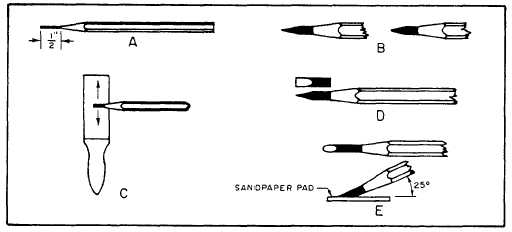lines do not appear, or appear too light, use a
softer pencil. If, on the other hand, lines appear
too dark in relation to other lines, use a harder
pencil. You may be able to vary the weight of lines
by the amount of pressure exerted on the pencil,
but this should not be attempted without
experience. Bearing down on a hard pencil to
produce darker lines may cause grooves in the
paper.
Another way to find out if you are using the
proper pencil is to hold your drawing up to a light
and view it from the back side. Pencil adjustment
is the same as in the previous method. Of course,
both methods apply only when transparent
drawing paper is used.
To sharpen a pencil, cut the wood away from
the unlettered end (fig. 3-1, view A) with a
draftsman’s pencil sharpener or a penknife. The
lettered end should be left intact so that the grade
of pencil can always be identified. The cut should
be started about 1 1/2 in. from the end, leaving
a half inch of lead exposed. To produce a
conical or needlepoint (fig. 3-1, view B), which
is best for general use, rotate the pencil between
the fingers at the same time as the exposed lead
is rubbed back and forth across the full length
of the sandpaper pad (fig. 3-1, view C). Many
draftsmen prefer to use a mechanical lead pointer
instead of the sandpaper pad. The mechanical
pointer quickly produces a uniform conical or
needlepoint. However, the sandpaper pad must
still be used to produce other types of points. The
resulting needlepoint should be dulled slightly by
drawing it lightly across a piece of scrap paper
several times. Avoid sharpening pencils near your
drawing. Graphite particles will cause smudges
that are difficult to erase. A cloth or tissue should
be used to wipe away graphite particles that cling
to the pencil after it is sharpened. A wedge point
(fig. 3-1, view D) will aid an experienced
draftsman in the extensive drawing of straight
lines. This point is produced by sharpening a
pencil to the conical point just described, then
flattening both sides on the sandpaper pad. For
an elliptical point, hold the pencil firmly with
thumb and fingers and cut the lead on the sand-
paper pad by a back-and-forth motion, keeping
the pencil at an angle of about 25 degrees to the
pad. Continue until a flat ellipse is formed, as
shown in figure 3-1, view E. A good draftsman
never uses a dull pencil.
Some draftsmen prefer to use mechanical
drafting pencils instead of wooden pencils. The
lead of a mechanical pencil is sharpened in the
same manner as the lead of a wooden pencil.
However, the length of the mechanical pencil is
not depleted as the lead is sharpened. This is an
advantage over wooden pencils that become
difficult to use when they are less than 3 in. in
length. When leads for the mechanical pencil are
exchanged, ensure that the changeable lead grade
designator on the mechanical pencil corresponds
to that of the lead used.
BASIC DRAFTING TECHNIQUES
You should practice handling and using
drafting instruments before attempting complex
drawing problems. Developing correct drawing
habits will enable you to make continuous
improvement in the quality of your drawings. The
Figure 3-1.-Sharpening pencil points.
3-3


